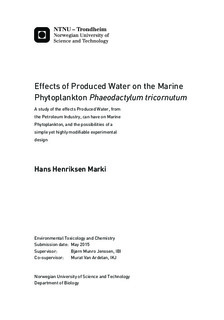| dc.description.abstract | Produced Water (PW) is a complex mixture of many chemical compounds, ranging from heavy metals and dispersed oil to Polycyclic Aromatic Hydrocarbons (PAHs), Alkylphenols (APs), and even production chemicals. In the following study the effects of PW discharged from the Norwegian Petroleum Industry was studied on the marine phytoplankton Phaeodactylum tricornutum, a species of marine diatoms. The experimental design of this study was focused on simplicity, and the ability to modify the methods for future studies was discussed. The results from this study shows effects of PW as a mixture of all the compounds mentioned above. The toxic effects, seen in the results as growth inhibition or effects on different parameters of algal growth, was compared to effects seen in early life-stages of fish, zooplankton and other microalgae species. The many different parameters measured in this experiment could all be an indication of growth, but as they all indicated growth by different reactions or factors in algal growth, the results were hard to discuss and any direct conclusions or correlations was difficult to justify. The most interesting results was found in a delay in pH change, visible in the pH results from the exposure group with the highest PW concentration, 10% PW. When this lack of pH increase, which was unexpected with algal growth, occurred, while other tests showed growth in all cultures, a possibility of growth and even photosynthesis without the use of CO2 was suggested. This result was in part correlated with a study on volatile hydrocarbons and their effect on Lipid : Chlorophyll a ratio in algal cells, although any definite conclusions was not justifiable based on this study alone. The differences between the results from all tests show that the ability to test and consider many factors and parameters are important when studying microalgae. Many earlier studies assume that algal growth rates can be directly extracted from one parameter measuring growth , but this study suggest heavy considerations of the actual chemical reactions behind results from a growth experiment are required to properly understand what any result actually show. | |

